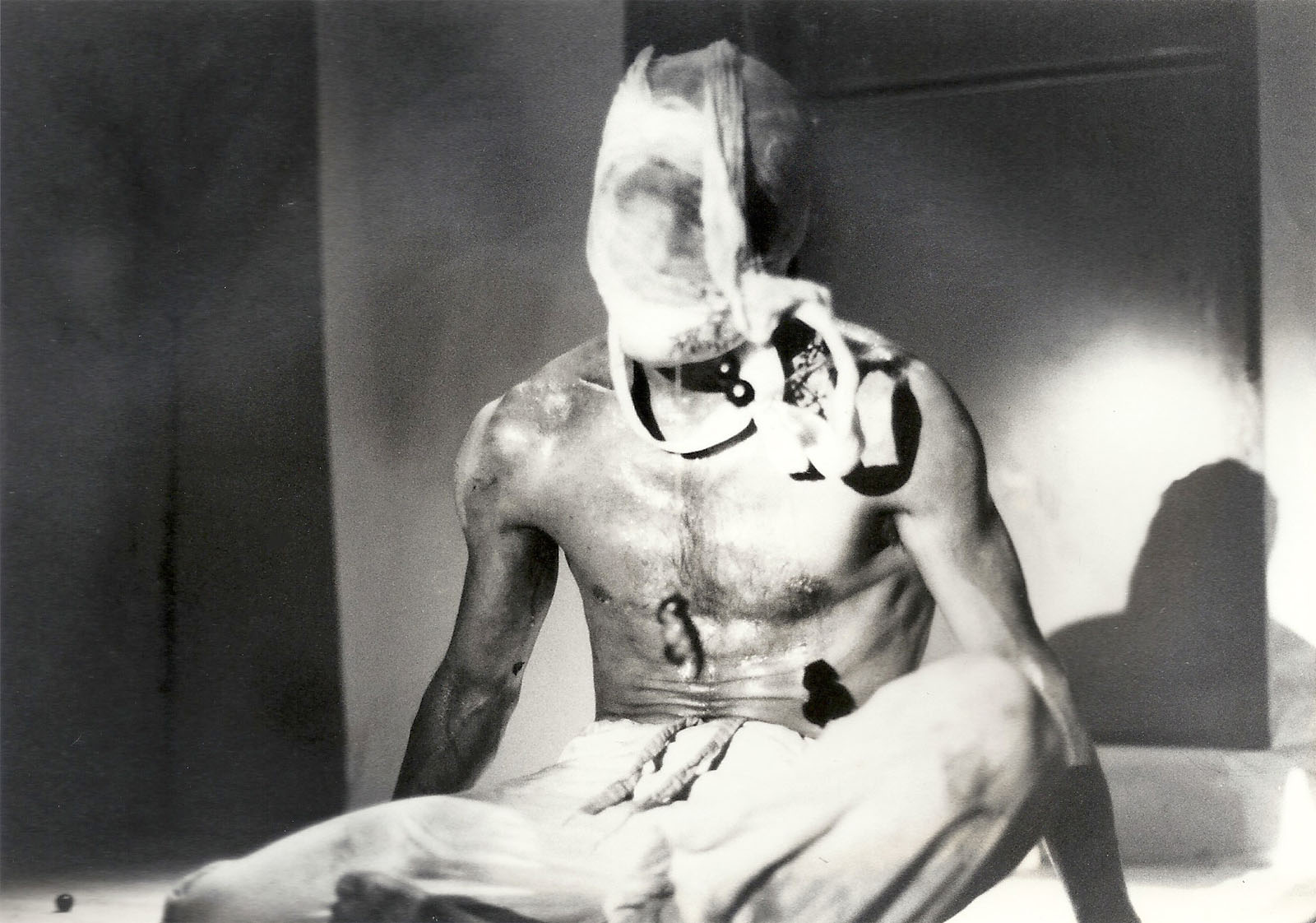
Hinagata 7 - Intermezzo: Intermission
Hidenaga Otori
While the Butoh itself goes without saying, the theater was spectacular. At Lotus Cabaret Shy, located in Minami Aoyama right beside the metro station of Gaienmae, I thought to go see the Butoh performance under the exaggerated title of “Hinagata 7, Explosion of NEON or NEANT” of the Butoh artist Ko Murobushi.
Of course, the spectacularity of the theater was only beginning of the deep impressions I had in regards to Butoh. The initiation for assisting in Ko Murobushi's plans started at the entrance of the theater.
The flyer I had in my hand had “The Opening of Shy” written on it, so I had imagined the opening of a pretty little cabaret theater, but my expectations were splendidly betrayed. It was located in the basement of a multi-tenant building, and of course, and there was nothing stylish that made it lobby-like.
What was called a landing was a narrow space that (felt ashamed to call landing) barely caught one's attention. Right beside it was the entrance door, and a reception desk just managed to fit on the landing. Moreover, the door was an iron door.
When the iron door was finally opened, beyond was an extremely sudden flight of concrete stairs. Taking care not to slip and fall, when I descended the flight of stairs, I was met with a dead end. The concrete walls were left bare, and that narrow corner that resembled a storehouse was the theater.
There were thirty reserved seats which certainly made it narrow, though they were merely white sheets spread out on the floor.
When one sat down in the seat, or rather, floor, a white curtain hung before one's eyes. The space felt small and it was like being locked up in something like a prison. When I thought the man at the reception just might be the jailer, I gradually came to understand that he was the gatekeeper to hell. In other words, this was the inside of a tomb.
It is said that, at the graveyard, humans interact with eternity. Just short of thirty patrons, we were led by Murobushi, and as we wondered what we would be meeting and what was beyond the white curtain, all of a sudden, it went black. From there was the start of what was called Butoh. At any rate, it was an admirable drection.
As the name says, the underground graveyard was everlasting darkness, and before long, between the white curtain and the white floor, the figure of a person crouched down rose to the surface. The resident mummy within the grave, its face wrapped in white bandages and kimono worn backwards, crouched there with something like a red obi over its head, weakly wriggling.The trembling became movement, and this man whose eyes were taken from him stood up soon after; this action may have perhaps been expressing the awakening in the realm of the underworld. And what this awakening brought with it at the same time was agony. This endless movement on top of the small, square stage between the white curtain and the white floor may have been hinting at the fact that this man was never to be set free from the place that is this very spot. The curtain behind him came to look increasingly overbearing and it was indeed suffocating. Resounding from beginning to end, the sound filled the interior of the narrow graveyard entirely, and until the sound came to grow so high that it pierced the ears, the man held his ears. It could be seen that this man's agony had already become near madness, but Murobushi's agony and madness were forcing an almost unbelievable kind of self-torment on us.
However, when Murobushi defyingly cast aside the overbearing white cutain behind him and a pale, transparent light shone from beyond the curtain, we felt an indescribable kind of catharsis.
Of course, white bandages were still wrapped around the artist's face, and the awakening and agony of the man whose eyes were taken from him continued.
Soon after, he disappeared into the refrigerator that was behind the stage, and the stage was wrapped in darkness. The darkness continued on for a while, and just as comical sounds came from within it, donning the white clothing of a young girl, Murobushi came moving along to the music. The man with his shaven head rolled back the whites of his eyes and, from the neck, removed the head piece of the costume of the young girl that looked like a wedding dress. This movement along to the comical rhythm was quite grotesque and humorous.
As I watched this humorous and grotesque dance, I was reminded of Margaret in Velazquez's “Les Meninas.” The refreshing impression this man's reappearance gave was most certainly for the purpose of a vivid transition from a nature of tragedy into a nature of comedy.
As the liberation from this point onwards was relished, fire traveled along the concrete wall. When Murobushi made the fire flare up at the back of the stage, the narrow interior of the grave was engulfed in fire, enveloped in raging flames. We recoiled for a moment, and Murobushi, passing the agony of the awakening and finally reaching the joy of life, freely manipulated the fire and transformed into that of the carnal under the concept “Sebi! To stand in the most beautiful flame of that anatomy and place of death.”
Sending back the death of language to the awakening of the carnal body, the artist endlessly slices away at the carnal body. With his performance from the awakening to manipulating the fire and becoming “a man who can overcome man,” Murobushi's carnal body that sliced away at the carnal released a consistent, metaphysical brilliance, and it was a beautiful and deeply moving performance.